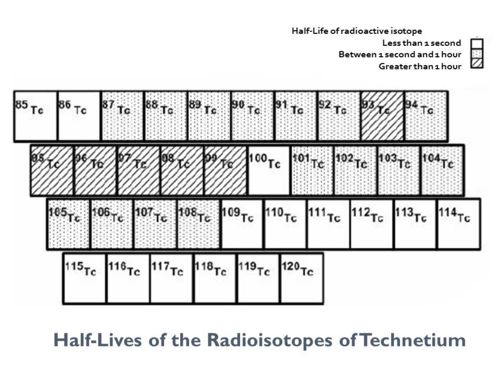Technetium
| |||||||||||||||||||||||||||||||||||||||||||||||||||||||||||||||||||||||||||||||||||||||||||||||||||||||||||||||||||||||||||||||||||||||||||||||||||||||||||||||||||||||||||||||||||||||||||||||||||||||
Technetium is a chemical element, having the chemical symbol Tc. Its atomic number (the number of protons) is 43. It has a standard atomic weight of 98.9062 g•mol −1 and is a solid in its elemental form.
Technetium is considered to be a member of the "Transition metal" class of elements.[1] At a pressure of 101.325 kPa, it has a boiling point of 4,265 °C and a melting point of 2,157 °C.
All the isotopes of technetium are radioactive; 98 is the atomic mass of technetium's longest-lived isotope, 98Tc (4.12x106 years).[2] Technetium has the lowest atomic number of the chemical elements that lack a stable isotope.
Only very small amounts of technetium are found in nature.[3] Practically all technetium is produced synthetically as a by-product of the fission of uranium-235 in nuclear reactors and it is extracted from the spent reactor fuel rods.[4]
Technetium radioisotope half-lives
References
- ↑ Note: Technitium is also sometimes referred to being a member of a Synthetic or Quasi-synthetic class of elements.
- ↑ Technetium Isotope data.
- ↑ Schwochau K. (2000) Technetium: chemistry and radiopharmaceutical applications. Wiley-VCH. ISBN 9783527294961. | Google Books preview.
- See section 3.2 for history of discovery of technetium in Earth's crust.
- ↑ John Elmsley (2001). Nature's Building Blocks: An A-Z Guide to the Elements, 1st Edition. Oxford University Press. ISBN 0-19-850341-5.
